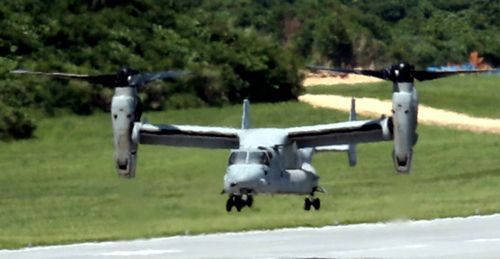Futenma-based MV-22 Osprey crashes off the coast of Australia seven months after an accident in Okinawa, people concerned and angered

Photograph: An MV-22 Osprey tiltrotor aircraft which made an emergency landing on the U.S. Iejima auxiliary airfield came back to the Futenma base on June 7
August 6, 2017 Ryukyu Shimpo
An MV-22 Osprey belonging to U.S. Marine Corp Air Station Futenma crashed off the coast of Australia on August 5. Only seven months have passed since the Futenma-based MV-22 crashed on the coast of Abu, Nago City, last December.
Concerns and angers have since spread among citizens.
The community is saying; “MV-22 Osprey crash again?”, “We do not know when and where it will fall.
It is really dangerous,” and “Do not fly it again.”
The U.S. military resumed its MV-22 operations only a few days after last year December’s crash in Nago.
The U.S. military continues its routine training of MV-22 Ospreys, which take off from the Futenma base and carry out training in various places in the prefecture such as Ginowan City, the U.S. Marines Northern Training Center in Higashi and Kunigami Villages, Shirohara Ward in Gninoza Village, Naha City, Ie Village and so on.
Shoichi Kawada, 66, who lives in Abu, Nago, said, “this accident happened less than one year after the crash of Abu.
The U.S. military should not fly Ospreys again.”
An Osprey made an emergency landing on Ie-jima Island in June this year.
“The Osprey was once again proven to be a flawed machine,” Ryosho Henzan, the head of Majya District, Ie-jima Island, emphasized.
“This is a miserable government. The government will not listen even if we speak out on the dangers to try to stop the Osprey’s operations.”
Ikuko Isa, 56, who lives in Takae Ward, Higashi Village, stressed, “The Ospreys always fly over Takae and we do not know when they will crash.
Okinawan people need to demand the withdrawal of the Ospreys deployment once again.”
In Shirohara Ward, Ginoza Village, local people have been suffering from the noise and dust pollution caused by the Ospreys’ takeoff and landing training. Hidemasa Sakihama, the head of the ward, said, “There was the Osprey’s crash in Abu and an incident in which something dropped off an aircraft in Camp Hansen. You can easily imagine easily that such an incident could take place. ”
Toshio Takahashi, 64, the executive secretary of the plaintiffs in the second Futenma noise lawsuit, lives in an area about 150 meters away from the Futenma base. Takahashi said, “Emergency landings and night trainings have been on the increase recently.
I feel uneasy about safety because the probability of accidents will increase especially at nighttime.”
Zenji Shimada, 77, a Ginowan City resident and the president of the plaintiffs in the second Futenma noise lawsuit, said, “We have indicated that the MV-22 Osprey is a flawed aircraft. If the Osprey aircraft is deployed across the country, there will be a crash in the other prefectures.
This is not only a problem in Okinawa.”
On August 12, an Okinawa prefectural people’s rally will be held to push the Japanese and the United States governments to cancel the construction of the new U.S. base in Henoko.
Co-representative of All Okinawa Kaigi (All Okinawa Coalition) Ai Tamaki, a 22-year-old Uruma City resident, said, “Because there are the U.S. military bases, people in Okinawa always live in danger of accidents.
The country’s officials say that they will protect Okinawa and Japanese people’s lives and properties, but we do not feel we are being protected at all.”
(English translation by T&CT)
Previous Article:New US Ambassador to Japan Hagerty plans to visit Okinawa in consideration of military base issues
Next Article:Housing potentially damaged by Osprey training in Ginoza
[Similar Articles]
- Residential complaints ignored, Ospreys continue to take off and land in the middle of the night
- Takae residents request removal of Osprey to ODB in light of recent crash accident
- Seven years after the deployment of MV-22 Ospreys to MCAS Futenma, night flights outside the agreed upon times increasing
- US Marine Corp to deploy Osprey at Futenma Air Station
- Higashi Village Assembly demands nearby U.S. military helipads be removed, claiming, “The training are increasing, and residents live in fear”
 Webcam(Kokusai Street)
Webcam(Kokusai Street)


